Foundation
Izumo Taisha is more than a shrine. It’s a legend, a symbol, a reminder of a once glorious past. It’s the country’s foremost shrine for enmusubi (love connections). It’s got the biggest honden (inner sanctuary) in Japan, and the biggest shimenawa (rice rope) in the world. Experts think at one time it may have had the tallest building in the world too. According to some, it’s the oldest of all Shinto shrines, dating back to before the imperial ancestors ‘descended from heaven’. It remains, even now, second only to Ise in the popular imagination.
in reality no one is sure when exactly the shrine was founded. There was a religious site here around 2000 years ago, for magatama sacred beads and halberd offerings were found nearby. Speculation has suggested a date in the seventh century for the establishment of the shrine. No doubt, like elsewhere, worship in the early centuries took place outdoors and was focussed on the hilltop or sacred rock.
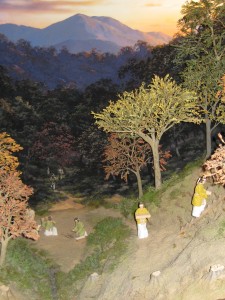
Burial of ritual swords to the mountain kami opposite
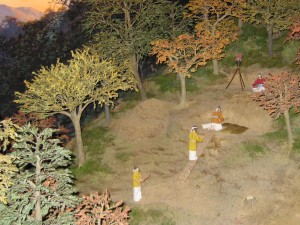
Reconstruction of the ritual at Kojindani, where 358 swords were offered to the kami
In the Shimane Museum of Ancient Izumo, next to the shrine, is an exhibit showing the burial of 358 bronze swords at the Kojindani site.
The swords were found in 1984 and are thought to have been offerings to the mountain god opposite. Alongside the swords were bronze bells and spearheads.
The exhibit gives an idea of how worship must have been 2000 years ago: open-air, and up on the hillside. It’s notable here that Shinto scholar Ponsonby-Fane claimed the Izumo Taisha site was originally settled by immigrants who practised ancestor worship on the hill behind the present shrine. It was only with advances in civilisation that there came a move towards the building of shrines at the foot of the hills.
Okuninushi, kami of Izumo Taisha
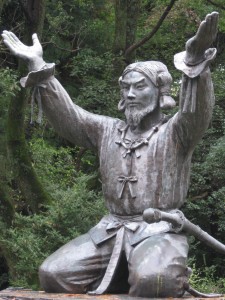
Statue of Okuninushi in front of the shrine
The main deity of the shrine is Okuninushi, a mythological descendant of Susanoo. He ruled over the land of Izumo at a time when the rival Yamato kingdom was pressing its claims to national supremacy. He’s remembered not only as an earthly ruler, but as ‘the god of marriage’. There are a number of famous stories associated with him: one is the ceding of Izumo to Yamato.
According to Nihon shoki, Yamato cast an envious eye on Izumo and sent emissaries, who either defected or were defeated. Finally they mounted a show-down, before which an aging Okuninushi submitted, in consultation with his sons. According to the terms of the treaty, the country was to be divided, with Yamato taking charge of the worldly realm and Izumo the spiritual.
It’s thought the treaty may have taken place at the beginning of the fifth century. In Izumo there were square burial mounds in the fourth century. Keyhole mounds, as used in Yamato, started to appear in the mid-fifth century. By the 540s Izumo representatives were at the Yamato court.
As part of the treaty with Izumo, the Yamato authorities agreed to build a magnificent palace for Okuninushi. (He was also later honoured as a kami called Onomuchi at the Yamato shrine of Omiwa.) Most likely, Okuninushi’s palace was turned into a shrine to his memory some time after his death. It’s worth noting here that the same word (miya) is used for palace and shrine – in a culture of ancestor worship, dead rulers became kami.
The rabbit and the princess
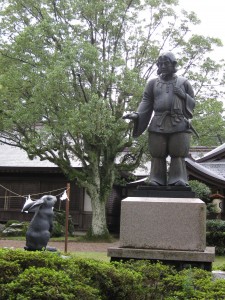
Okuninushi and the rabbit he rescued
There are two other famous legends about Okuninushi. One has to do with the white rabbit of Inaba. It used to live on the island of Oki and tricked some sharks into letting it jump over their backs to the mainland. The angry sharks took revenge by skinning the rabbit.
it so happened that Okuninushi and his band of brothers happened to be passing through Inaba at the time, when they came upon the rabbit. The brothers had fun by telling the rabbit to go wash in the salty sea. Okuninushi oin the other hand took pity on it and suggested fresh water and a covering of soft cattail. This proved effective and the rabbit was cured.
In gratitude the rabbit became an ally of Okuninushi, aiding and protecting him in his future travails. It serves now as his familiar.
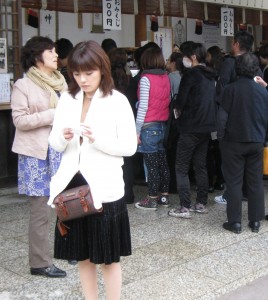
Young woman eagerly checking her fortune slip while others queue
Another story tells of Okuninushi escaping persecution by running to the underworld, where he met and fell in love with Susanoo no mikoto’s daughter, a princess called Suseri-hime. Susanoo put him to the test with a roomful of snakes, which he survived thanks to a blue scarf Suseri had given him. Further tests followed, which again he survived thanks to other scarves supplied by Suseri-hime. When Susanoo showed no intention of letting up, the lovers escaped back to Izumo where they built a palace, married and lived happily ever after.
The happy marriage with Suseri-hime led to the tradition of ‘enmusubi‘ (good connections) for which the shrine is famous. It means there are always young girls around, eagerly reading fortune slips and purchasing love amulets. Of all the wedding halls in Japan, that of Izumo is said to be the most highly prized.
(Incidentally, an archaeologist at my university suggested the association of Okuninushi and enmusubi arose from his role as host to all the other kami of Japan. During the many meetings they hold, Okuninushi takes the prime role in networking and making important connections between them.)
There’s one further aspect to Okuninushi, for he became conflated with one of the seven lucky gods called Daikoku. Why? Simply because the reading of the Chinese characters is the same in both cases. Daikoku is a pot-bellied deity who carries a sack on his back, promising a financial windfall for those who beseech him. Go to Izumo Taisha then, and fortune may well lie in store for you – in more than one sense!
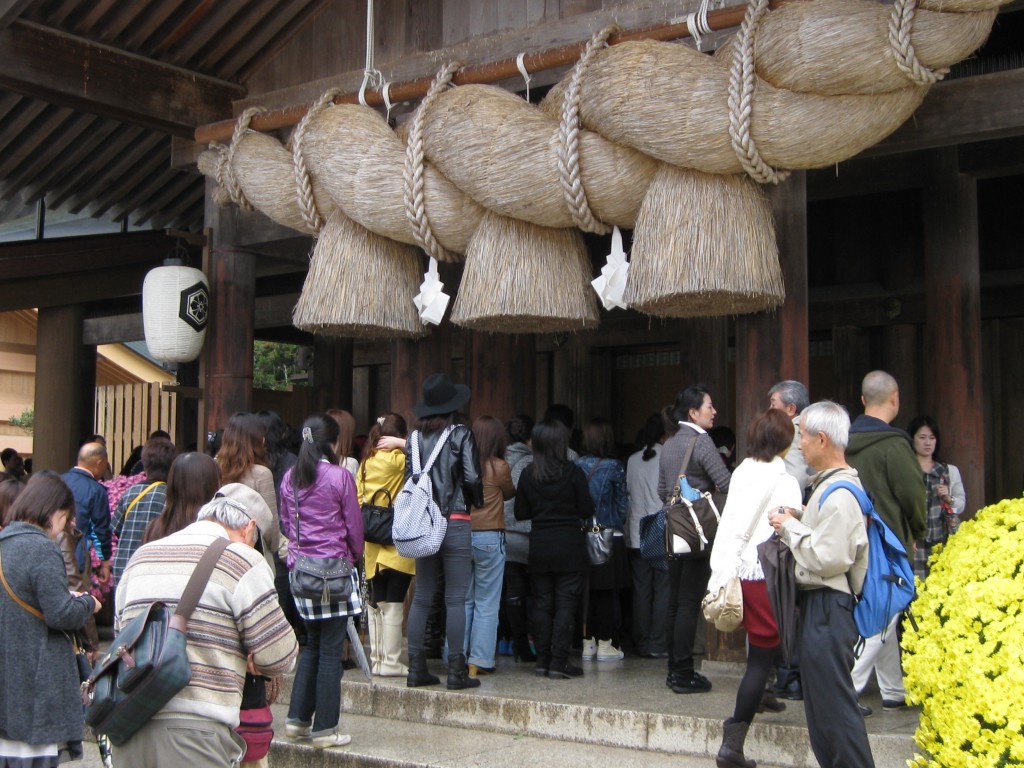
Lining up beneath the trademark Izumo shimenawa, symbolic of the 'knot' that Okuninushi ties between people
************************************************************************************************************************************************
For some stunning photos of Izumo Taisha, see ojisanjake’s blogspot.
Information for this article drew on Joseph Cali’s forthcoming Guide to Shinto Shrines

Information for this article drew on Joseph Cali’s forthcoming Guide to Shinto Shrines
Speaking of which… Do you have any word on when this book will actually be released??
Yes, the latest word is that it will be out in the autumn… I gather that after Kodansha International folded, another publisher has stepped in and adopted the title. Hopefully things will go smoother this time round…
Wow, Kodansha is out of business? I hadn’t heard! Bummer… but I’m glad your book was picked up, I’ve been looking forward to it.